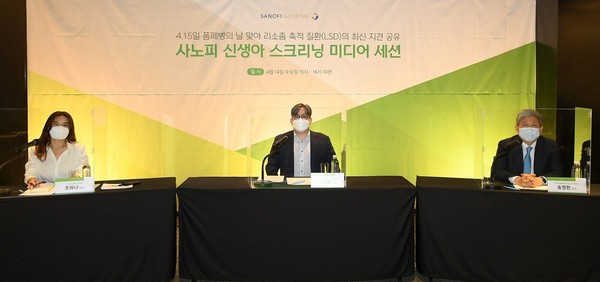“We can delay the onset of most lysosomal storage disorders (LSD) with steady treatment thanks to enzyme replacement treatment (ERT). However, symptoms already progressed are irreversible even after ERT. So, it is very important to detect the disease early and start treatment immediately.”
Professor Kim Yoo-mi of the Pediatric Department at Chungnam National University Hospital said this and other remarks at the Newborn Screening Media Session, held by Sanofi Genzyme on Wednesday.

LSDs are rare inherited diseases causing an abnormal buildup of toxic materials in the body’s cells due to abnormalities in the lysosome, which removes unnecessary substances from the body.
Depending on the type of the deficient enzyme, LSDs cause about 50 types of metabolic diseases. LSDs are known to occur in one per 5,000 people.
About 400 Korean patients were diagnosed with LSDs, according to Kim. Of them, 150 have Mucopolysaccharide, and another 150, Fabry disease, and about 40 have Gaucher disease, another 40, Pompe disease.
“The awareness of the disease is low in Korea, and in some cases, it took more than 10 years to get the accurate diagnosis after symptoms appeared,” she said.
Kim went on to say that LSD is a progressive disease that worsens with age, and untreated LSD could lead to early death.
In the past, patients with LSDs could receive only temporary therapy to relieve symptoms. However, recently developed treatments such as ERT could slow the disease progression and improve the patient’s quality of life, she explained.
“For an early diagnosis of LSD, physicians should consider LSD when a patient shows clinically inexplicable symptoms,” Kim emphasized.
According to Kim, Gaucher disease's clinical symptoms include growth failure, enlarged liver and spleen, decreased platelets, and bone pain. In the early stage of Fabry disease, patients can experience fatigue, sweating disorders, skin rashes, corneal opacity, and angiokeratoma. In the late stage, heart and kidney damage, early stroke, or kidney failure could occur. Patients with Mucopolysaccharide show frequent respiratory infections, hernias, and skeletal abnormalities on X-rays.
Patients with Pompe disease show myocardial hypertrophy and muscle weakness due to the glycogen accumulation in the muscles. This can result in respiratory failure. Most infant Pompe disease patients who develop the disease before one year old may die due to cardiac hypertrophy and respiratory failure before turning two if the disease is not treated with ERT.
Professor Song Jung-han of the Laboratory Medicine Department at the Seoul National University Bundang Hospital presented the newborn screening status in LSDs and emphasized the need for reimbursement for the screening.
Newborn screening (NBS) refers to a test for the early diagnosis of treatable diseases in asymptomatic newborns.
“NBS can help patients get an early diagnosis of LSDs and proper treatment to prevent irreversible damages, and induce genetic counseling for families with mutated genetic factors,” Song said.
Also, NBS reduces the stress associated with delays and uncertainties in the diagnosis of LSDs and helps support an optimized treatment strategy that considers each patient's disease characteristics, he added.
In 2020, the health insurance benefits were available for 15 inherited metabolic diseases, including LSDs, and it is possible to receive a test for Gaucher disease and Mucopolysaccharide for about 30,000 won at a general hospital, according to Song.
However, Pompe disease and Fabry disease tests are not reimbursable, and they cost about 100,000 won, respectively.
“NBS is the most efficient diagnostic method that enables early diagnosis of LSD,” Song said. As most patients and their guardians notice the symptoms belatedly, they find that the disease has already progressed at the time of the diagnosis.
“So, we need to detect LSD early using NBS and build a treatment strategy as soon as possible.”

